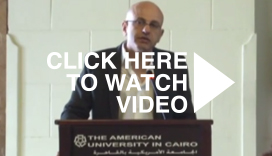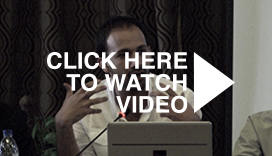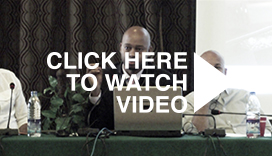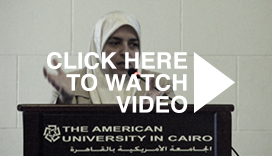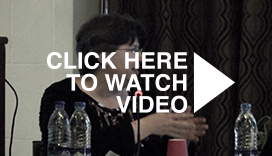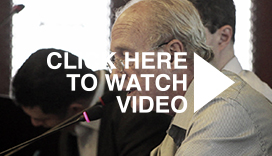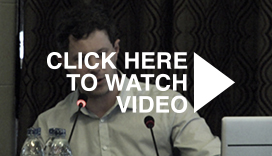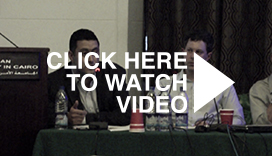
Urban Political Change: Southern Perspectives
Video of Presentation by Khaled Fahmy, Department of History, AUC
Video of Presentation by Gautam Bhan, Indian Institute for Human Settlements, Delhi
Video of Presentation by Mokena Makeka, Makeka Design Lab
The session proceeded to discuss urban political change, with historian Khaled Fahmy emphasizing the critical role of urban control in society. Fahmy’s presentation centered around an alternative, historically documented view of the origins of Khedive Ismail’s Cairo.
Fahmy referred back to 2002, when inadequate dialogue between the Egyptian people and their governing institutions precluded citizens’ agency, and compelling change. In a sort of “he who controls the streets controls the people” mantra, urban control became a means to prevent civic dialogue. The January 25th Revolution revealed the power of allowing civic dialogue, which is necessary for effective change.
Fahmy outlined, through documents archived in Dar al-Watha’iq al-Misriya (Egypt’s Book and Documentation Authority), how the betterment of Cairo’s citizens underscored earlier designs of Khedivean Cairo. These documents challenge the popular view of the heralded urban designs as eurocentric, the aesthetic copy known as “Paris on the Nile.” Fahmy’s research indicates that the primary drive of that vast urban project was the wellbeing of its citizens and the desire to create a healthy, safe environment for its occupants. By contrast, today’s top-down planning approaches, such as Cairo 2050, have veered away from this bottom-up approach, to the detriment of citizens. These historical lessons suggest that the way forward for architects and urbanists is to remain citizen-centric rather than form-centric, and to work with the rights and general betterment of Cairo’s dwellers in mind.
The second presentation, by Gautam Bhan of the Indian Institute for Human Settlements, focused on the role of public space as a platform for processes of political change. Bhan presented the post-colonial Indian experience, which began with national urban citizenship. He critiqued the urban lexicon inherited from this period in India’s history, with its overarching master planning and contemporary irrelevance to urban citizens. Through various examples of Indian street movements, he raised the idea of the “impoverishment of poverty.” This involves: exclusion from the imagined economy; the rise of a new elite urban citizenship; and an altered representation of the poor. He proposed that it is such discord that sometimes drives revolution.
The final presentation was by Mokena Makeka of South Africa’s Makeka Design Lab. Makeka, speaking as a practitioner, explored the right to the city and the emerging role of the designer as facilitator of this right.
He examined this in light of the South African experience, which is compounded by issues of race, which are “geographized” – keeping the poorest and predominantly black communities farthest from resources and services. The irony of this dynamic is that the poor still vote for the very people who keep them in poverty. In his work Makeka tries to regain ownership of such spaces for the people, particularly those spaces that previously were icons of oppression. In his practice he cultivates cultural references, including inspiration from local mythology, to create an aesthetic vocabulary of reclamation.
The panel discussion Urban Political Change: Southern Perspectives with Khaled Fahmy, Gautam Bhan, and Mokena Makeka, brought together three speakers representing three different national territories and three different disciplines. The different yet complementary perspectives offered by the speakers shed light on how they each negotiate their role and practice between disciplinary normative narratives and structures, and the specificities of the contexts in which they work. The three panelists also spoke about the city as site for the contested relation between state and society. Ultimately, the panel departed from the boundaries of North-South frameworks for discussing urban issues in Egypt, and allowed for Southern perspectives to emerge as a viable alternative for these debates and conversations. Although Southern perspectives and South-South comparison entered academia some time ago, such debates have not had much traction in Egypt to date, and this panel was a clear demonstration of the relevance of such perspectives to the Egyptian case.
Omar Nagati
Omar Nagati is a Ph.D. candidate and practicing architect/urban planner living in Cairo. A graduate of Cairo University, he studied and taught at the University of British Columbia and…
Video of Presentation by Khaled Fahmy, Department of History, AUC
Khaled Fahmy
Khaled Fahmy is Professor in and Chair of AUC’s Department of History. After graduating from AUC with a B.A. in Economics and a M.A. in Political Science, Fahmy pursued a DPhil from Oxford…
Video of Presentation by Gautam Bhan, Indian Institute for Human Settlements, Delhi
Gautam Bhan
Gautam Bhan is a Senior Consultant for Curriculum Development and Policy and Advisory Services at the Indian Institute for Human Settlements. Gautam’s research and writing has focused on the politics…
Video of Presentation by Mokena Makeka, Makeka Design Lab
Mokena Makeka
Mokena Makeka is principal and founder of Makeka Design Lab. His highlight was being selected among 100 architects globally by Herzog and de Meuron to be a part of the…
Video of Q&A led by Mohamed Elshahed, Cairobserver
Mohamed Elshahed
Mohamed Elshahed is a doctoral candidate in the Middle East and Islamic Studies Department at New York University. He lives in Cairo, where he is conducting dissertation research on architecture…
Video of Presentation by Heba Raouf Ezzat, Cairo University
Video of Presentation by Lindsey Sherman, Urban-Think Tank, Caracas, Zurich
Introduced by moderator Diane Singerman, Associate Professor in the Department of Government at American University, this panel was grounded in the Cairo context by Heba Raouf Ezzat, a public intellectual, writer and professor of political theory at Cairo University where she has published widely on issues of citizenship and women in politics.
Ezzat outlined the inextricable importance of space and place in the discussion of citizenship, stating: “Citizenship cannot be separated from cities, because cities are the manifestation of existential, political, social, economic needs and rights and duties.” Throughout her discussion she presented three concepts from the work of UC Berkeley’s Nezar ElSayyad: hybridity as a model to understand the city and spaces of power; the fundamentalist city; and medieval citizenship.
Ezzat went on to discuss the phenomenon of spontaneity, particularly as applied to the case of Cairo. Referring to the work of David Sims, she presented
[…] how people resort to creating their own spaces and running their own places, so the flows of power change and the state becomes marginalized rather than the people becoming marginalized. Right to the City: Emergent Practices in Latin America They simply marginalize the state in their life and go on, starting from sewage to urban informal housing to parallel education to transportation and everything; the toktoks and the tiny little tricycles that are all over the place. Flows of power and flows of influence change, and the whole map changes. Where can we then, and how can we then understand that the political has been, over many years in Egypt, informalized, or the informal politicized?
Lindsey Sherman, Project Architect at Urban-Think Tank (U-TT), presented an alternative view of urban development that she termed “The Syncretic City.” She summarized this position as one whereby we can “learn from the existing city and translate this existing knowledge into new possible futures and design thinking modes outside conventional models.”
Sherman presented a critique of the rapid urbanization of the world’s cities, primarily in the informal sectors, and the growing problems this breeds; failing mobility systems, inequality in resource distribution, inaccessibility, poor environmental conditions and skewed dialogue across the social, political and economic realms. She posited that it is essential today to regard growing arenas of informality as being full of potential, rather than as pockets of urban dissent, to be ignored and endured until they can be eradicated.
In her presentation of the case of U-TT’s work in Caracas, Sherman illustrated how they work with these very potentials. She discussed the advantages of placing their practice in the middle ground between top-down or formal processes and bottom-up or informal practices; and the unique platform this creates. She presented their “Syncretic City” philosophy as such a platform, which calls on architecture to evolve not from “exclusion to inclusion but from exclusion to collaboration … a productive coexistence of different forces, where a new city can be built in, on and with the old.”
This philosophy is clearly illustrated through U-TT’s MetroCable project in San Agustín, Caracas. This project not only plugs into an existing formal transportation system but also allows the almost surgical insertion of services and a social network in what they call an “integrative infrastructure.” This project replaces the government-planned access road, providing more accessibility to the inhabitants of the neighborhood, while preserving their homes, increasing their safe mobility and providing much needed services at each landing point of the cable stations as plug-in programs.
Jennifer Bremer, Associate Professor of Public Policy and Chair of the Public Policy and Administration Department at AUC, addressed the public policy perspective on the growing informality of cities in her presentation of case studies from Latin America. She began by presenting the growing informality in Cairo, and across the globe, as a phenomenon that is quickly migrating from one of exception to one of majority. She introduced the concept of urban upgrading in its various forms, be it infrastructure upgrading, housing upgrading, services upgrading or even the securing of tenure.
In her presentation Bremer quoted Cities Alliance stating that
The upgrading of slums is not limited to housing construction or upgrading of existing buildings, the social component of the entire process is key, with the ultimate objective being the guarantee of access to life skills and to better living conditions, we’re talking about people, we’re not talking about buildings.
She went on to summarize this philosophy whereby
1) the slum dweller becomes the citizen; 2) the shack becomes the house, and 3) the slum becomes the suburb.
In the first Latin American upgrading example presented Bremer summarized key issues: defining the community; sustainability; coverage; implementation; and financing. Beginning with the example of the Institute for Liberty and Democracy in Peru, a legislative approach to upgrading was presented. By streamlining and simplifying the tenure process, the Organismo de Formalisatión de la Propiedad Informal (COFOPRI) aimed to secure titles for one million citizens in informal areas, and exceeded that target by 300,000 titles.
In her second example she outlined the Brazilian Favela-Bairro Program. The main objectives of this project were to provide urban improvements, particularly urban infrastructure, and to create and provide access to urban facilities for social benefits. The total cost was $300 million, funded largely by the Inter American Development Bank, with equal contribution from the city. The services they provided included training centers for artisans, schools, hostels and government facilities among many others.
Finally Bremer concluded with Patrimonio Hoy, a program initiated by cement giant CEMEX. This program built on the realization that 40 percent of CEMEX sales were to individuals who were constructing their own homes. In response to this, the company began providing microcredit and technical assistance to home-builders to improve their homes as well as low-cost materials from other building materials companies.
1 Lefebvre, H., 1968 Le Droit à la ville, Paris: Anthropos (2nd ed.); Paris: Ed. du Seuil, Collection “Points”.
Heba Raouf Ezzat
Heba Raouf Ezzat has taught political theory at Cairo University since 1987 and at the American University in Cairo since 2006. She has been Visiting Researcher at the Centre for…
Video of Presentation by Jennifer Bremer, Department of Public Policy and Administration, School of Global Affairs and Public Policy, AUC
Jennifer Bremer
Jennifer Bremer is an Associate Professor of Public Policy and Chair of the Public Policy and Administration Department, the first public policy department in the Middle East and one of three academic…
Video of Presentation by Lindsey Sherman, Urban-Think Tank, Caracas, Zurich
Lindsey Sherman
Lindsey Sherman received her Master of Architecture from Columbia University, GSAPP and her Bachelor of Arts in Architecture and Business Administration from the University of California…
Video of Q&A led by Diane Singerman, Department of Government, American University, WashingtonD.C.; Tadamun: Cairo Urban Solidarity Initiative
Diane Singerman
Diane Singerman is an Associate Professor at American University, Washington D.C. She is a comparativist whose research interests focus on political change from below, particularly in the Middle East…
Video of Presentation by Damon Rich, Division of Planning and Community Development, Newark, NJ
Video of Presentation by Gregers Tang Thomsen and Selva Gürdoğan, Superpool, Istanbul
Video of Q&A led by Ayman Ismail, Department of Management, School of Business, AUC
Damon Rich, Chief Urban Designer for the city of Newark, spoke of his role as a “cheerleader for local democracy” and the necessity for designers and architects to use the tools available to them to “make the processes of governance more transparent, accessible, and manipulable.” Citing Saul Alinsky’s notion of “building power” in his discussion of what it means to produce a public, Rich addressed urban designers’ attempts in Newark “to weave together the people in the city to produce outcomes,” as well as the perspective of city residents who, when they found their needs were not being met by the municipal government, formed constituencies, and learned “the nuts and bolts of making demands and holding governments accountable.”
Rich presented examples of his work in Newark creating tools to “break down processes by which planning and development happen in the city,” to produce a collective notion of how things work. Community-based projects he spearheaded include the creation of a physical model of the city by Newark residents, who worked with local architecture students to recreate the buildings in their neighborhood. Rich highlighted the way in which this workshop generated “a narrative beyond the fact of people coming together,” by registering this act in the physicality of the design itself. From engaging community and school groups in the creation of public art on city walls, to a campaign to redesign the waterfront that seeks to engage two percent of all Newarkers, the projects Rich presented embodied his vision of urban designers as advocates for citizen engagement. He concluded by outlining his view of urban designers as “one group amongst a very diverse field looking for unexpected collaborations in order to make the city that we want.”
David Sims gave an overview of informal urban development in greater Cairo. In contrast to development trends since January 2011, including worsening traffic and a lack of investment in road infrastructure; crises and stalled real estate development in the new towns; and the slow progress of Metro Line Three; Sims pointed out that informal urban development, already dominant, has accelerated considerably.
Sims spoke of the multiple reasons for informality working well in Cairo, including informal developments’ advantageous locations (forming a ring around the formal city) for residents commuting to jobs and accessing business opportunities. In addition he argued that these densely built areas “beat new towns for sustainable urban development.”
Sims argued that today up to 85 percent, if not more, of the increase in population of greater Cairo is in informal areas, with remittances sent to Egypt from abroad being invested in these developments. He concluded that the future of Cairo, in terms of people and employment, is in informal areas, which he anticipates will eventually be provided with infrastructure services by the state.
Gregers Tang Thomsen and Selva Gürdoğan of Superpool spoke of the similarities between Cairo and their home city of Istanbul, with respect to the lack of local administrative capacity to engage communities in planning, and the need for small architecture offices such as their own to provide ideas to fill such gaps. They presented two lines of their work, one related to transportation and mapping, the other to zoning rules with respect to informal housing projects currently undergoing formalization.
Superpool displayed the map they created of Istanbul’s dolmuş minibuses, a widely used network of transportation that the city does not include in its smart ticket system. While the Istanbul transportation authorities have produced their own dolmuş maps, they have not made these available to the public, allegedly because they were unable to produce a legible specimen, yet also indicative of their lack of investment in this alternative transportation system. Superpool expressed their interest in dolmuş minibuses as an archetype for flexible, shared modes of transportation. They emphasized the efficiency of these shared systems, with one minibus replacing the equivalent of 20 cars on the road.
Presenting their work undertaken as part of the Audi Urban Future Initiative, on the future of mobility in Istanbul, Superpool explored the shared minibus system as a model from the past that can inform the future. They proposed an interactive system, Park™ that would link transportation systems to public space through an online loyalty program. Addressing issues of traffic, mobility, community building, and public participation, Park™ promoted an engaging way to communally manage public space, at a time when debates over city plans for public spaces, including Taksim Square, were beginning to rage.
Superpool ended their presentation with an overview of a collaboration they are participating in with a number of young architecture offices, organized by an agency by the name of Urban Strategy, to explore changes in Kağıthane, an informal neighborhood that has been formalized over time through government intervention. In response to what they termed “questionable” urban renewal policies, these young firms have on their own initiative prepared design guidelines for the municipality, in an effort to redress inequitable rebuilding precedents.
Ayman Ismail, as moderator, concluded the session by warning against the adoption of narrative extremes in planning: from visions of urban renewal, such as Cairo 2050, that promote demolishing “slums,” to the other narrative extreme, which romanticizes informal areas. He advocated for a pragmatic narrative that takes into account present demographic and physical realities, as a means for identifying new solutions that provide for a mix of upgrading, new developments, transportation, and parks in Cairo.
David Sims
David Sims is an American economist and urban planner who has led a number of studies about Cairo’s urban development and housing…
Video of Presentation by Damon Rich, Division of Planning and Community Development, Newark, NJ
Damon Rich
Damon Rich is a designer and artist, and currently serves as Chief Urban Designer for the City of Newark, New Jersey. In Newark, Damon leads design efforts with public and private…
Video of Presentation by Gregers Tang Thomsen and Selva Gürdoğan, Superpool, Istanbul
SUPERPOOL
SUPERPOOL: Selva Gürdoğan, Architect (born 1979, Turkey. 2003 graduate from Sci-Arc, USA) and Gregers Tang Thomsen, Architect (born 1974, Denmark. 2003 graduate from Aarhus School of Architecture, Denmark) founded Superpool in Istanbul in 2006…
Video of Q&A led by Ayman Ismail, Department of Management, School of Business, AUC
Ayman Ismail
Ayman Ismail is Assistant Professor and Abdul Latif Jameel Endowed Chair of Entrepreneurship at AUC School of Business, Department of Management. Ismail graduated with an MBA from the American University…

